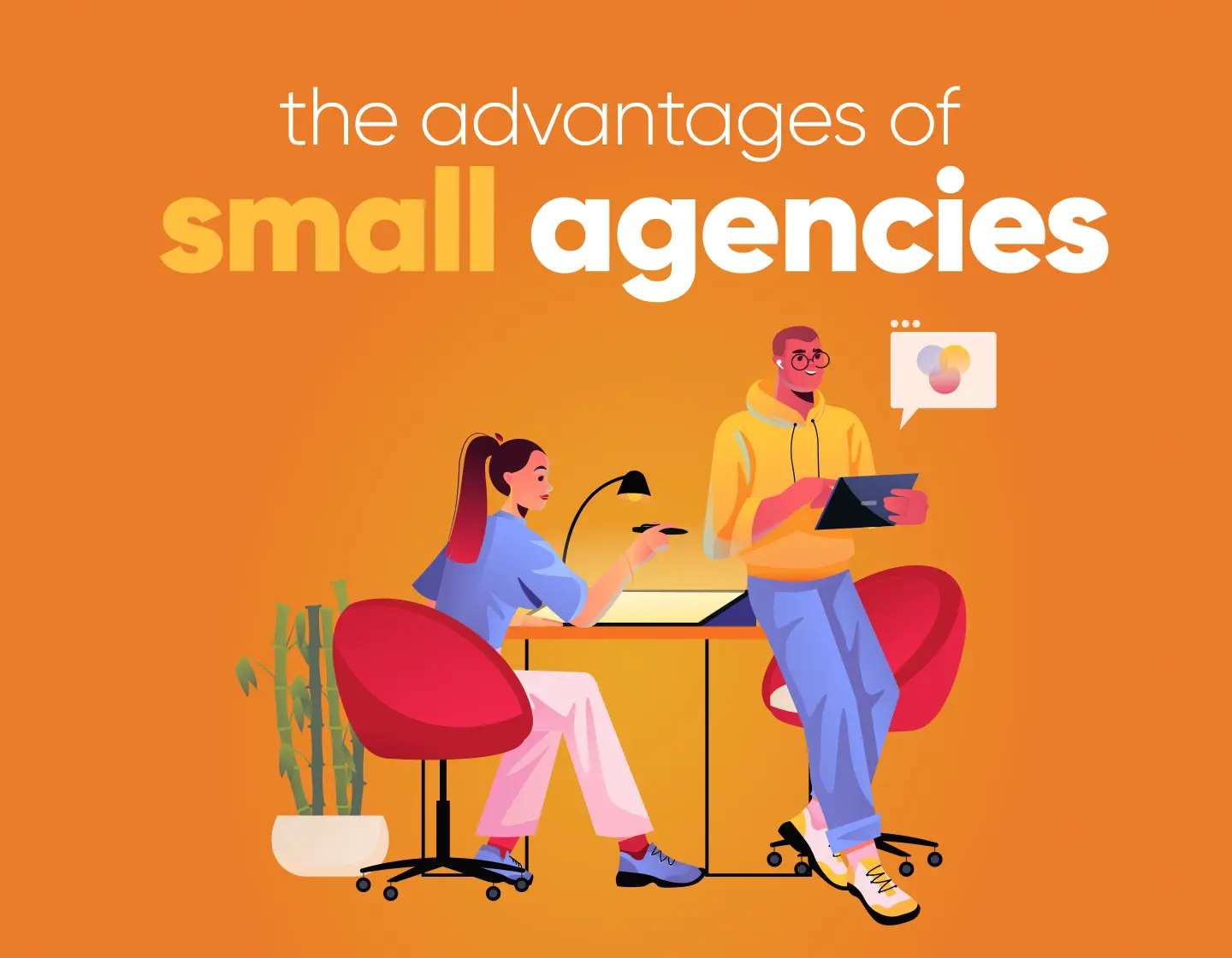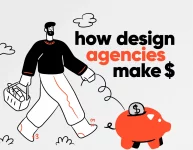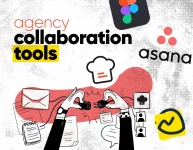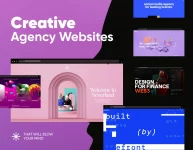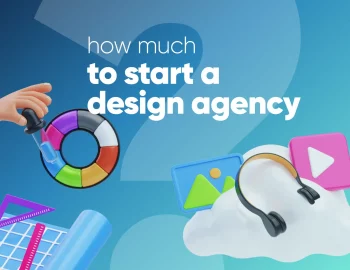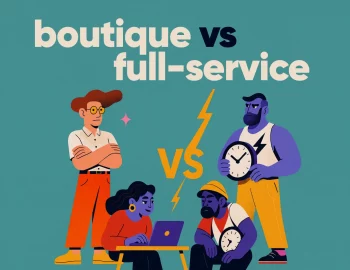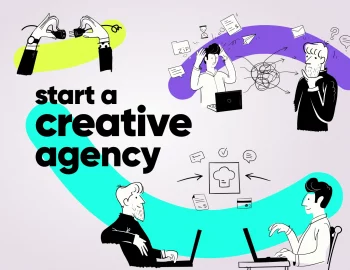The advantages of small design agencies often get overshadowed by big names and big budgets, but that’s changing. More clients are discovering that smaller teams bring sharper focus, faster collaboration, and a more personal approach to creative work.
Still, it’s not always easy to communicate that. When you’re pitching against agencies with bigger headcounts and broader name recognition, it can feel like you’re constantly trying to prove you belong in the same room.
This article is here to help you flip that – with clear, confident messaging, real differentiators, and ready-to-use phrases that frame your size as a strategic strength, not a limitation. Let’s dive into it!
The Big Agency Illusion: Why “More” Isn’t Always Better
There’s a reason big agencies often win by default – they look impressive on paper. Polished websites, global clients, and all-in-one services give the impression of scale and sophistication. For many businesses, that looks like the safer choice.
But behind the scenes, things can get messy. Creative projects move through multiple departments, losing clarity and momentum along the way. Unlike larger agencies, small ones don’t bury work in bureaucracy or handoffs – they stay close to the brief and to the client.
Many clients also find that unless they’re a top-tier account, personalised attention becomes rare. Response times are slow. Vision gets diluted.
Working with a small design agency offers distinct advantages: faster feedback loops, clearer communication, and a team that’s all-in from day one. To make that resonate, you don’t need to downplay the competition – just own what makes you better.
The Small Design Agency Advantages
Small design agencies don’t just compete with big firms – they win. Why? Because while the big guys scale wide, small teams go deep. They’re skillful, relationship-driven, and built to deliver outstanding results without the slowdowns. Here are the strongest benefits of working with a small design agency:
1. Direct access to talent
Clients don’t want a game of telephone. They want real conversations with the people doing the work. In smaller agencies, clients aren’t funneled through layers of account managers – they’re speaking directly with the team members shaping their brand’s visual identity.
2. Agility & speed
Big companies often need weeks to shift direction. Small agencies can make a U-turn in days or hours. With fewer approval loops and tighter communication, compact teams move fast without sacrificing quality.
3. Deep client involvement & real collaboration
Smaller teams create space for clients to be part of the design process. That means fewer handoffs, more clarity, and better results because the vision doesn’t get watered down along the way.
4. Focused, specialised expertise over generalized services
Big design agencies often try to be everything to everyone. Small agencies succeed by being exceptional at a few things. That focus leads to sharper thinking, deeper specialization, and stronger outcomes.
5. Better value with lower overhead costs
Small agencies offer cost-effective solutions – high-quality work without the overhead of a massive operation. That doesn’t mean cheaper – it means more of your budget goes to actual creative execution, not to agency overhead.
6. Stronger relationships, long-term partnerships
Small teams are in it for the long haul. Clients aren’t one of dozens rotating through a system – they become actively incorporated core collaborators. That consistency and care lead to trust, retention, and better work.
Let’s be clear: this isn’t about competing on size – it’s about winning on experience, attention, and results. When you lead with those strengths, your size becomes a strategic advantage, not something to explain away.
Positioning Tips: How to Present a Small Agency as Premium and High-Value
Honestly speaking, the biggest challenge isn’t what small design agencies offer, it’s how to talk about it to their advantage – in a way that feels premium, not apologetic. You don’t need to overexplain your size. You need to own your edge. Here’s how to do it:
1. Lead with outcomes, not organizational charts
Don’t compare team sizes – compare results. Clients care about what you’ll deliver, not how many people are in the room. Focus your messaging on the quality, clarity, and impact of your work.
Instead of: “We’re a small team, but we’re experienced…”
Try: “We provide innovative design solutions with a streamlined, senior-led team.”
2. Set boundaries like a premium partner
Small doesn’t mean always-on. Being collaborative doesn’t mean being reactive. Protecting your time and creative process signals confidence, not fragility.
Instead of: “We’re flexible and always available…”
Try: “We’re focused and intentional – and that means fewer delays and stronger outcomes.”
3. Price for value, not for size
Don’t fall into the trap of “small = lower cost.” If anything, lean teams offer more value per dollar because of reduced overhead and direct execution. Your pricing should reflect the quality of your work, not your team count.
Instead of: “We’re more affordable than bigger firms…”
Try: “Your budget goes straight into strategy and execution – not into managing layers.”
4. Showcase process over scale
Larger agencies often sell “resources.” Small design agencies win when they sell clarity and use it as their advantage. Walk clients through your tight, smart process – it’s often faster and more collaborative than the big-agency version.
Instead of: “We’re lean and hands-on…”
Try: “Our streamlined process means less back-and-forth – and more time creating what matters.”
5. Speak about fit, not just capability
Remind prospects that it’s not just about who can do the work – it’s about who’s best suited to do it well. Some clients need a customized experience. Some want to work closely with you and have a deeper understanding of the process. Others don’t want to get passed around.
Instead of: “We’re just as capable as the large firms…”
Try: “We’re a better fit for clients that want deep involvement, fast turnarounds, and real creative partnership.”
When you position with confidence and clarity, you’re not competing on size – you’re making it irrelevant. And that’s where the real change happens.
What Kinds of Clients Prefer Small Agencies (and How to Attract Them)
Not every client needs an extended team with a complicated structure and a 30-slide onboarding deck. Some are actively seeking leaner, faster, more personal collaborative partnerships – they just need to know you’re the better fit. Here’s who those clients are and how to draw them in:
1. Startups & scale-ups
These clients move fast, test ideas, and want collaborators who can keep up. They don’t have time (or patience) for corporate-style project management – they want smart partners who are all-in and can turn directions quickly.
What to highlight: Agility, direct access, co-creation, and speed.
How to attract them:
- Use fast-paced, friendly copy that feels real, not stiff.
- Emphasize your experience working with early-stage teams.
- Share testimonials that mention flexibility and problem-solving.
2. Marketing leads at mid-sized companies
These folks often have internal pressures: too much to do, not enough hands. Thus, these businesses seek personalised attention and want an agency that feels like an extension of their team – reliable, strategic, and able to run with things without excessive oversight.
What to highlight: Responsiveness, senior-level thinking, ease of collaboration.
How to attract them:
- Showcase case studies where you supported or amplified an internal team.
- Talk about partnership, not just execution.
- Make your communication style feel frictionless and dependable.
3. Founders & brand owners
They’re emotionally invested in their brand and want a creative partner who gets it. Big firms can feel cold or impersonal, so they’re looking for connection, care, and a shared sense of ownership.
What to highlight: Personal attention, craftsmanship, and vision alignment.
How to attract them:
- Use a first-person, conversational tone in your copy.
- Emphasize long-term relationships and your passion for brand identity building.
- Include founder-friendly packages or services that they can understand quickly.
4. Clients disappointed by big design agencies
Some clients have gone the big-design-agency route and felt like just a number, and here lies your advantage. They want a smarter, leaner experience the second time around. This is your chance to win their trust by being the opposite of what they just escaped.
What to highlight: Consistency, transparency, trust.
How to attract them:
- Say the quiet part out loud (“We’ve heard the same story from clients too many times…”)
- Offer a smoother onboarding process.
- Be clear about who they’ll actually work with – and why that’s better.
At the end of the day, the clients who thrive with small design agencies aren’t those looking for “cheaper”, they are those looking for better, and this is another advantage. So, make it easy for them to see that in your positioning, creative projects’ offers, and your process.
Messaging Snippets You Can Steal Today
Sometimes you know what to say… but not quite how to say it. So here’s a helpful set of value-packed phrases, positioning lines, and one-liners you can steal, tweak, and drop straight into your sales copy, pitch decks, or onboarding materials.
♦ Framing your size as a strength
- “We’re not a big agency – and that’s by design. Every project gets senior-level attention from start to finish.”
- “Smaller team, sharper focus. You’ll always know who’s doing the work and why.”
- “We trade volume for depth – and it shows in the results.”
♦ Explaining your value
- “Your budget goes into creativity and strategy, not layers of overhead.”
- “We don’t take on 10 clients at once. We focus on a few, and go deep.”
- “We’re not here to impress you with our size – we’re here to impress you with our work.”
♦ Positioning your process
- “We work like a startup: fast, collaborative, and outcome-driven.”
- “You won’t need to sit through five status meetings to get answers – we move quickly and communicate clearly.”
- “Our process is built around clarity, not complexity.”
♦ Pitching against larger agencies
- “We’ve heard the same story from clients who’ve worked with large agencies – things move slowly, communication gets messy, and they feel like just another fish in the sea. That’s not how we do things.”
- “Big agencies are built for scale. We’re built for impact.”
- “When clients leave large firms and come to us, they’re often surprised by how much easier and more focused the experience is.”
♦ Closing the trust gap
- “You’re not just hiring us to check a box – we become an extension of your team.”
- “We’ve worked with fast-growing startups and challenger brands – they choose us because we meet them where they are, and help them grow.”
- “We’re small, yes – but mighty, strategic, and all-in on your success.”
Bottom line? Your size IS your strength
Being a small agency doesn’t mean you’re playing in a smaller league – it means you’re playing a different game. One that values impactful design solutions and results.
Also, clients aren’t just buying creative work – they’re choosing the experience of working with you. And that experience? It’s often clearer, closer, and more meaningful when it comes from a small, passionate team.
So don’t wait for permission to show up with confidence. Start reframing the conversation using messaging that reflects the real advantages you bring to the table as a small design agency – agility, access, care, clarity, and craft.
You’ve got everything you need to stand tall next to the big guys – not as a runner-up, but as the right choice for the right clients.
Interested in learning more about how to level up your creative agency game? Check out here:


